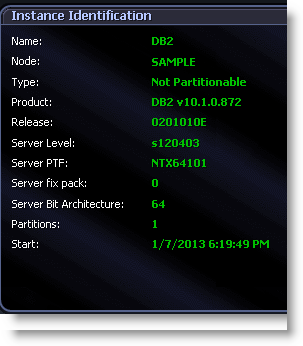The Instance Identification panel lists information about the monitored instance. The following illustration shows a sample Instance Identification panel.

Review the following for additional information about the items listed about the monitored instance:
| Item | Description |
| Name | The name as it is known on the server—of the DB2 instance you are currently monitoring. |
| Node | The name in the database manager configuration file at the client node. |
| Type |
One of the following DB2 node types are shown in this field:
|
| Product | The DB2 name and version number. |
| Release | The product code and version number for the DB2 client system on which the application is running. |
| Server Level |
The IBM build and PTF (Program Temporary Fix) levels of the current DB2 server and client. These numbers can be used to determine your fixpak level.
Determining IBM fixpak levelsTo check if your system is at the latest fixpak , run the db2level command on both the client and the server where the database resides. Note: You can execute this command from a DB2 command window. (On Unix or Linux platforms, you would run the command from the login prompt of your instance user ID.) This command will not run in the Command Line Processor ( CLP ). Once you have determined the fixpak level of your system, go to the following web page to ensure that this is the latest fixpak of DB2. If it is not, you should upgrade. |
| Server PTF | The IBM PTF (Program Temporary Fix) level of the current DB2 server and client. |
| Server Fixpack | The IBM level of the current DB2 server fix pack. If a fix pack is not installed, 0 (zero) is shown. |
| Server Bit Architecture | The size of the bit strings supported by the server processor. For example, 32 is shown for 32-bit processors; 64 is shown for 64-bit processors. |
| Partitions | The total number of partitions used by all the databases within the current instance. |
| Start |
The timestamp showing when the database manager was started via the DB2START command. The timestamp uses the following format: year-month-day hour:minutes:seconds.microseconds |